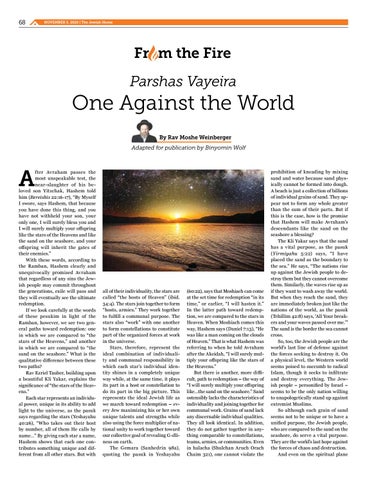68 64
NOVEMBER 5, 2020 | The Jewish Home OCTOBER 29, 2015 | The Jewish Home
From the Fire Parshas Vayeira
One Against the World By Rav Moshe Weinberger Adapted for publication by Binyomin Wolf
A
fter Avraham passes the most unspeakable test, the near-slaughter of his beloved son Yitzchak, Hashem told him (Bereishis 22:16-17), “By Myself I swore, says Hashem, that because you have done this thing, and you have not withheld your son, your only one, I will surely bless you and I will surely multiply your offspring like the stars of the Heavens and like the sand on the seashore, and your offspring will inherit the gates of their enemies.” With these words, according to the Ramban, Hashem clearly and unequivocally promised Avraham that regardless of any sins the Jewish people may commit throughout the generations, exile will pass and they will eventually see the ultimate redemption. If we look carefully at the words of these pesukim in light of the Ramban, however, we see two general paths toward redemption: one in which we are compared to “the stars of the Heavens,” and another in which we are compared to “the sand on the seashore.” What is the qualitative difference between these two paths? Rav Ezriel Tauber, building upon a beautiful Kli Yakar, explains the significance of “the stars of the Heavens.” Each star represents an individual power, unique in its ability to add light to the universe, as the pasuk says regarding the stars (Yeshayahu 40:26), “Who takes out their host by number, all of them He calls by name…” By giving each star a name, Hashem shows that each one contributes something unique and different from all other stars. But with
all of their individuality, the stars are called “the hosts of Heaven” (ibid. 34:4). The stars join together to form “hosts, armies.” They work together to fulfill a communal purpose. The stars also “work” with one another to form constellations to constitute part of the organized forces at work in the universe. Stars, therefore, represent the ideal combination of individuality and communal responsibility in which each star’s individual identity shines in a completely unique way while, at the same time, it plays its part in a host or constellation to do its part in the big picture. This represents the ideal Jewish life as we march toward redemption – every Jew maximizing his or her own unique talents and strengths while also using the force multiplier of national unity to work together toward our collective goal of revealing G-dliness on earth. The Gemara (Sanhedrin 98a), quoting the pasuk in Yeshayahu
(60:22), says that Moshiach can come at the set time for redemption “in its time,” or earlier, “I will hasten it.” In the latter path toward redemption, we are compared to the stars in Heaven. When Moshiach comes this way, Hashem says (Daniel 7:13), “He was like a man coming on the clouds of Heaven.” That is what Hashem was referring to when he told Avraham after the Akeidah, “I will surely multiply your offspring like the stars of the Heavens.” But there is another, more difficult, path to redemption – the way of “I will surely multiply your offspring like…the sand on the seashore.” Sand ostensibly lacks the characteristics of individuality and joining together for communal work. Grains of sand lack any discernable individual qualities. They all look identical. In addition, they do not gather together in anything comparable to constellations, teams, armies, or communities. Even in halacha (Shulchan Aruch Orach Chaim 321), one cannot violate the
prohibition of kneading by mixing sand and water because sand physically cannot be formed into dough. A beach is just a collection of billions of individual grains of sand. They appear not to form any whole greater than the sum of their parts. But if this is the case, how is the promise that Hashem will make Avraham’s descendants like the sand on the seashore a blessing? The Kli Yakar says that the sand has a vital purpose, as the pasuk (Yirmiyahu 5:22) says, “I have placed the sand as the boundary to the sea.” He says, “The nations rise up against the Jewish people to destroy them but they cannot overcome them. Similarly, the waves rise up as if they want to wash away the world. But when they reach the sand, they are immediately broken just like the nations of the world, as the pasuk (Tehillim 42:8) says, ‘All Your breakers and your waves passed over me.’” The sand is the border the sea cannot cross. So, too, the Jewish people are the world’s last line of defense against the forces seeking to destroy it. On a physical level, the Western world seems poised to succumb to radical Islam, though it seeks to infiltrate and destroy everything. The Jewish people – personified by Israel – seems to be the only nation willing to unapologetically stand up against extremist Muslims. So although each grain of sand seems not to be unique or to have a unified purpose, the Jewish people, who are compared to the sand on the seashore, do serve a vital purpose. They are the world’s last hope against the forces of chaos and destruction. And even on the spiritual plane
























